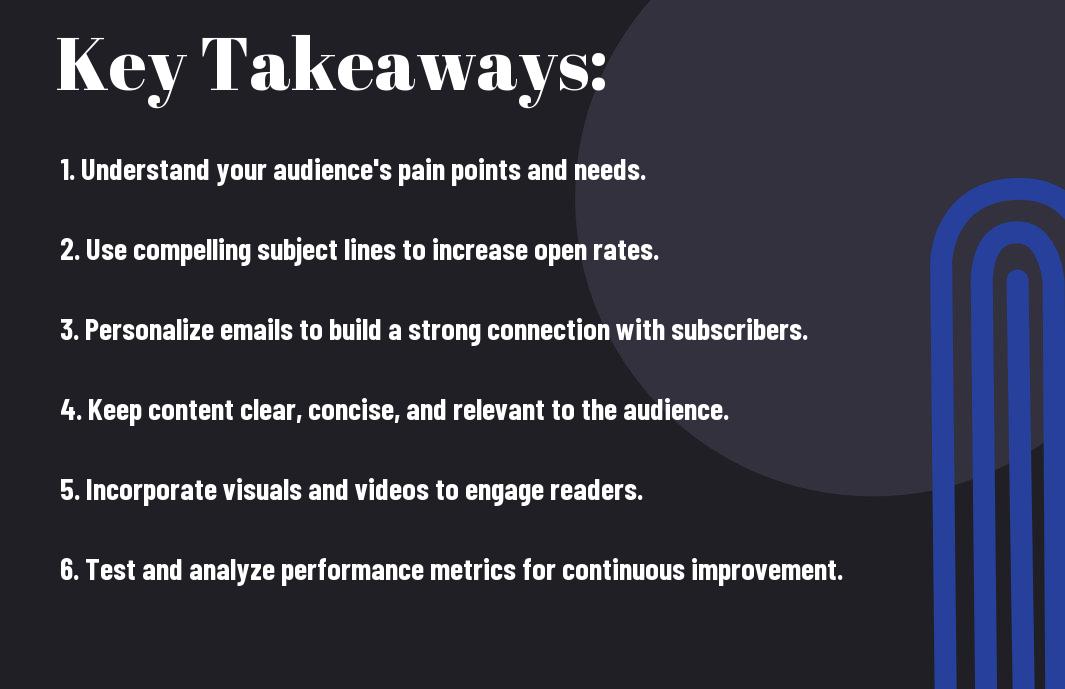Email marketing remains one of the most effective tools for businesses to reach their target audience. Crafting compelling email content is vital to grab the reader's attention and drive them to take action. In this blog post, we will explore the key strategies and best practices for creating engaging and persuasive email marketing content that converts. From understanding your audience to utilizing powerful calls to action, we will provide you with valuable insights to enhance your email marketing campaigns. Let's dive in and learn how you can take your email content to the next level!
Key Takeaways:
- Understand Your Audience: Tailor your email content to meet the specific needs, interests, and preferences of your target audience.
- Use Engaging Subject Lines: Grab your reader's attention with a compelling subject line that entices them to open the email and see what's inside.
- Focus on Value: Provide valuable and relevant content that resonates with your audience, such as exclusive offers, helpful tips, or educational resources.
Understanding Your Audience
Segmenting Your Email List
Even though you may have a large email list, not all subscribers are the same. The key to creating compelling email marketing content is segmenting your list based on various factors such as demographics, purchase history, and engagement level. This will allow you to send targeted emails to specific groups of subscribers, increasing the chances of engagement and conversions.
Creating Personas for Targeted Content
The
Even though segmenting your email list is important, creating personas takes it a step further by developing detailed profiles of your ideal customers based on research and data. By creating personas, you can tailor your email content to meet the specific needs, preferences, and pain points of each group, resulting in more personalized and relevant communication that resonates with your audience.
Another way to gather information for creating personas is by conducting surveys or interviews with existing customers to gain insights into their motivations, challenges, and buying behaviors.
Crafting Your Message
Writing Attention-Grabbing Subject Lines
To create attention-grabbing subject Lines, you need to be concise and compelling. Your subject line is the first thing recipients see, so it needs to stand out in a crowded inbox. Make sure it is relevant to the content of your email and sparks curiosity or offers value. Personalization can also significantly increase open rates, so consider including the recipient's name or other personalized elements.
Composing Engaging Body Content
As far as crafting engaging body content for your marketing emails, remember to keep it Your. Use short paragraphs, bulleted lists, and subheadings to make the content easy to digest. Remember to focus on the benefits to the reader and include a clear call-to-action that prompts them to take the next step. It's necessary to maintain a consistent tone and voice throughout the email to keep readers engaged.
For more tips on crafting compelling email content, check out How to Write a Marketing Email: 10 Tips for …
Optimizing Email Design
Visual Appeal and Readability
Not only is the content of your marketing emails important, but the design is also a crucial factor in engaging your audience. An email that is visually appealing and easy to read will increase the chances of your subscribers actually consuming the content you've worked so hard to create. Keep your design clean and uncluttered, use a readable font, and incorporate images strategically to enhance your message.
Responsive Design for Mobile Devices
To ensure that your emails are effective across all devices, including smartphones and tablets, it is vital to implement responsive design. An email that is not optimized for mobile devices can appear distorted and be challenging to read, leading to a high bounce rate and low engagement. By utilizing responsive design techniques, you can create emails that automatically adjust to the screen size of the device, providing a seamless user experience for all recipients.
The importance of responsive design for mobile devices cannot be overstated in today's digital landscape. With more and more people accessing their emails on mobile devices, neglecting this aspect of email design can result in a significant loss of engagement and potential customers. By prioritizing responsive design, you can ensure that your email marketing efforts reach their full potential.
Implementation and Testing
Best Practices for Email Scheduling
Now let's investigate into the best practices for email scheduling. Timing is crucial when it comes to email marketing. Consider your target audience's time zone and habits when scheduling your emails. Test different timings to see when your subscribers are most active and likely to engage with your content. Keep a close eye on your email performance metrics to determine the optimal sending schedule for your audience.
A/B Testing for Performance Improvement
Performance is key in email marketing, and A/B testing is a powerful tool to enhance your campaign performance. By testing different elements such as subject lines, call-to-action buttons, images, and content, you can identify what resonates best with your audience and drives higher engagement. Use A/B testing to experiment with one variable at a time and track the results to make informed decisions for future campaigns.
Plus, don't forget to segment your email list and tailor your A/B tests to specific audience segments. This will help you deliver more personalized content that speaks directly to the interests and preferences of each segment, leading to higher conversion rates and overall campaign success.
Advanced Email Marketing Strategies
Your email marketing strategy can be taken to the next level by implementing more advanced techniques to engage with your audience effectively.
-
Automation Personalization Automate your email campaigns to send targeted messages to your subscribers based on their actions or behaviors. Personalize your emails with dynamic content that speaks directly to the recipient, increasing relevance and engagement.
Automation and Personalization
Advanced email marketing strategies involve using automation tools to streamline your campaigns and personalization tactics to make the content more relevant to your audience. By segmenting your subscribers and sending automated, personalized emails, you can improve open rates, click-through rates, and ultimately, conversions.
Integrating Email with Other Marketing Channels
With the rise of omnichannel marketing, integrating email with other marketing channels can significantly enhance your overall marketing strategy. By combining email with social media, content marketing, and other channels, you can create a cohesive brand experience for your audience.
For instance, you can use email to drive traffic to your social media profiles or promote your content marketing efforts. By leveraging multiple channels together, you can reach a wider audience, increase brand visibility, and improve customer engagement across various touchpoints.
Measuring Success
Many companies invest time and resources into creating engaging email marketing campaigns. However, the true measure of success lies in how well these campaigns perform. Understanding how to measure the effectiveness of your email marketing efforts is necessary for optimizing future campaigns and achieving your business goals.
Key Performance Indicators (KPIs)
An necessary part of measuring the success of your email marketing campaigns is identifying and tracking Key Performance Indicators (KPIs). These KPIs help you gauge the performance of your campaigns against your goals. Common email marketing KPIs include open rates, click-through rates, conversion rates, and unsubscribes. By monitoring these metrics, you can determine what is working well and what areas need improvement.
Analyzing and Acting on Email Metrics
Metrics such as open rates and click-through rates provide valuable insights into how recipients are engaging with your email content. Analyzing these metrics allows you to identify trends, patterns, and areas for improvement. By acting on these insights, such as adjusting subject lines, content, or send times, you can optimize your future email campaigns for better results.
Measuring the success of your email marketing campaigns is crucial for driving continuous improvement and achieving your business objectives. By paying close attention to KPIs and email metrics, you can make informed decisions that lead to more effective campaigns and better ROI.
Final Words
So, creating compelling email marketing content requires a strategic approach that focuses on understanding your audience, delivering valuable information, leveraging storytelling techniques, and optimizing for mobile devices. By incorporating these key elements, you can effectively engage with your subscribers, drive conversions, and build lasting relationships with your audience. Remember to continuously measure and analyze the performance of your email campaigns to identify what works best for your audience and make adjustments accordingly. With a thoughtful and data-driven approach, you can craft email marketing content that resonates with your subscribers and delivers real results for your business.
FAQ
Q: Why is creating compelling email marketing content important?
A: Creating compelling email marketing content is important because it helps engage and retain your audience, drive conversions, and build brand loyalty. Well-crafted content can grab the reader's attention, keep them interested, and compel them to take action.
Q: What are some tips for creating compelling email marketing content?
A: To create compelling email marketing content, consider personalizing the emails, using relevant and eye-catching subject lines, keeping the content concise and scannable, including a clear call-to-action, segmenting your email list, testing different content formats, and analyzing the performance of your emails to iterate and improve.
Q: How can I improve the effectiveness of my email marketing content?
A: To improve the effectiveness of your email marketing content, focus on providing value to your subscribers by offering useful and relevant information, leveraging storytelling to create emotional connections, optimizing your emails for mobile devices, nurturing relationships with your audience over time, and continuously experimenting with different strategies to see what resonates best with your subscribers.

